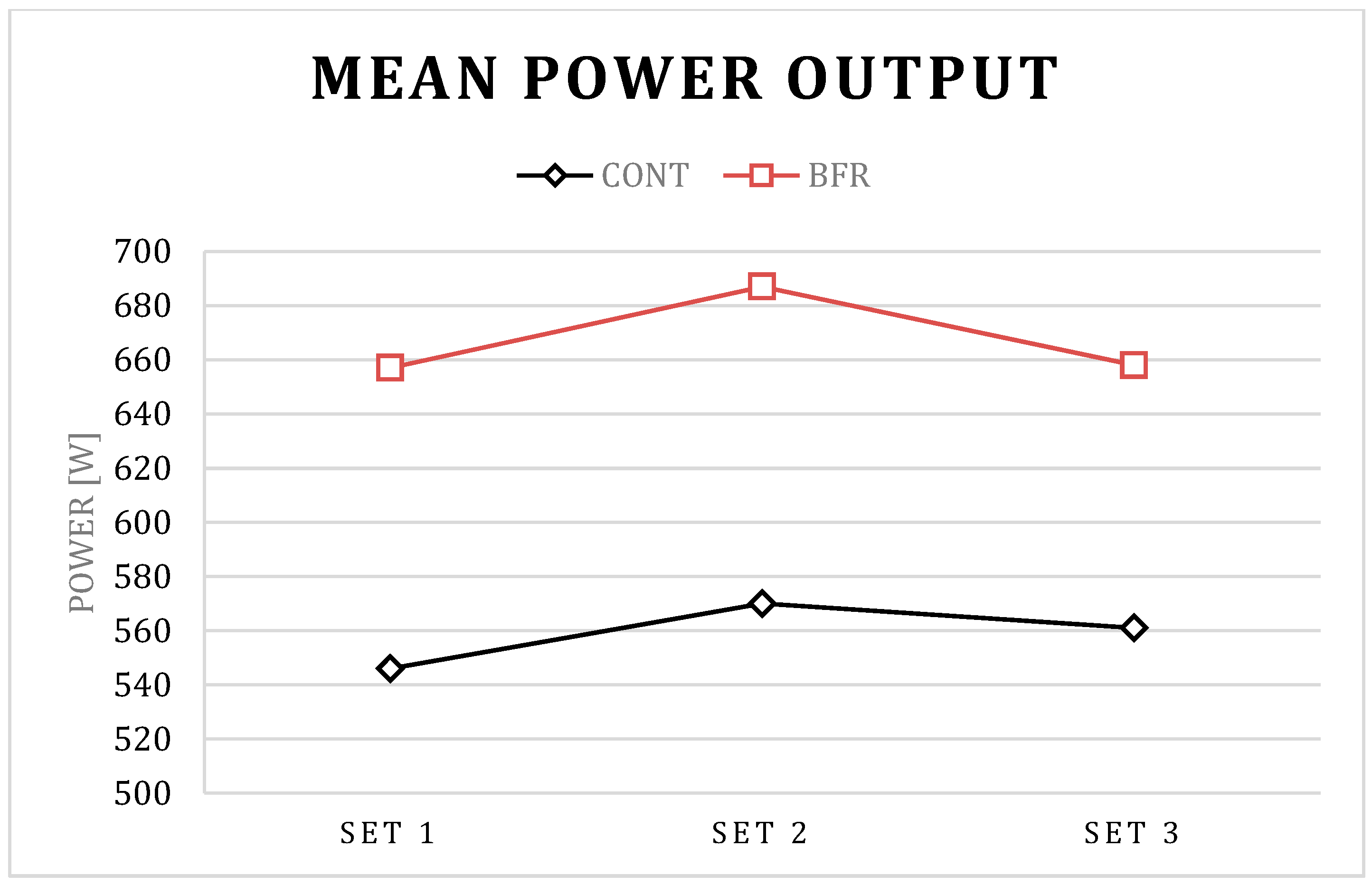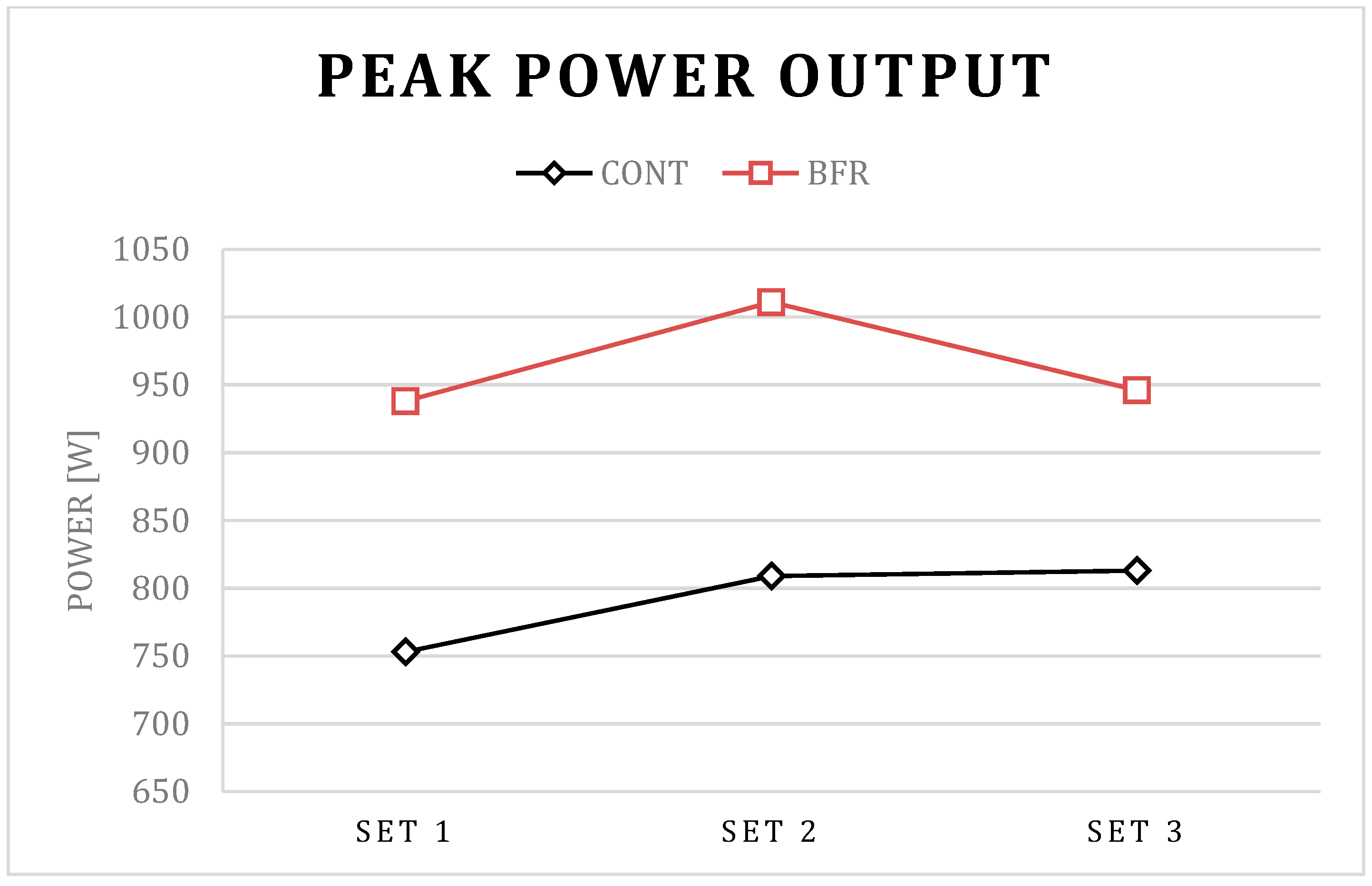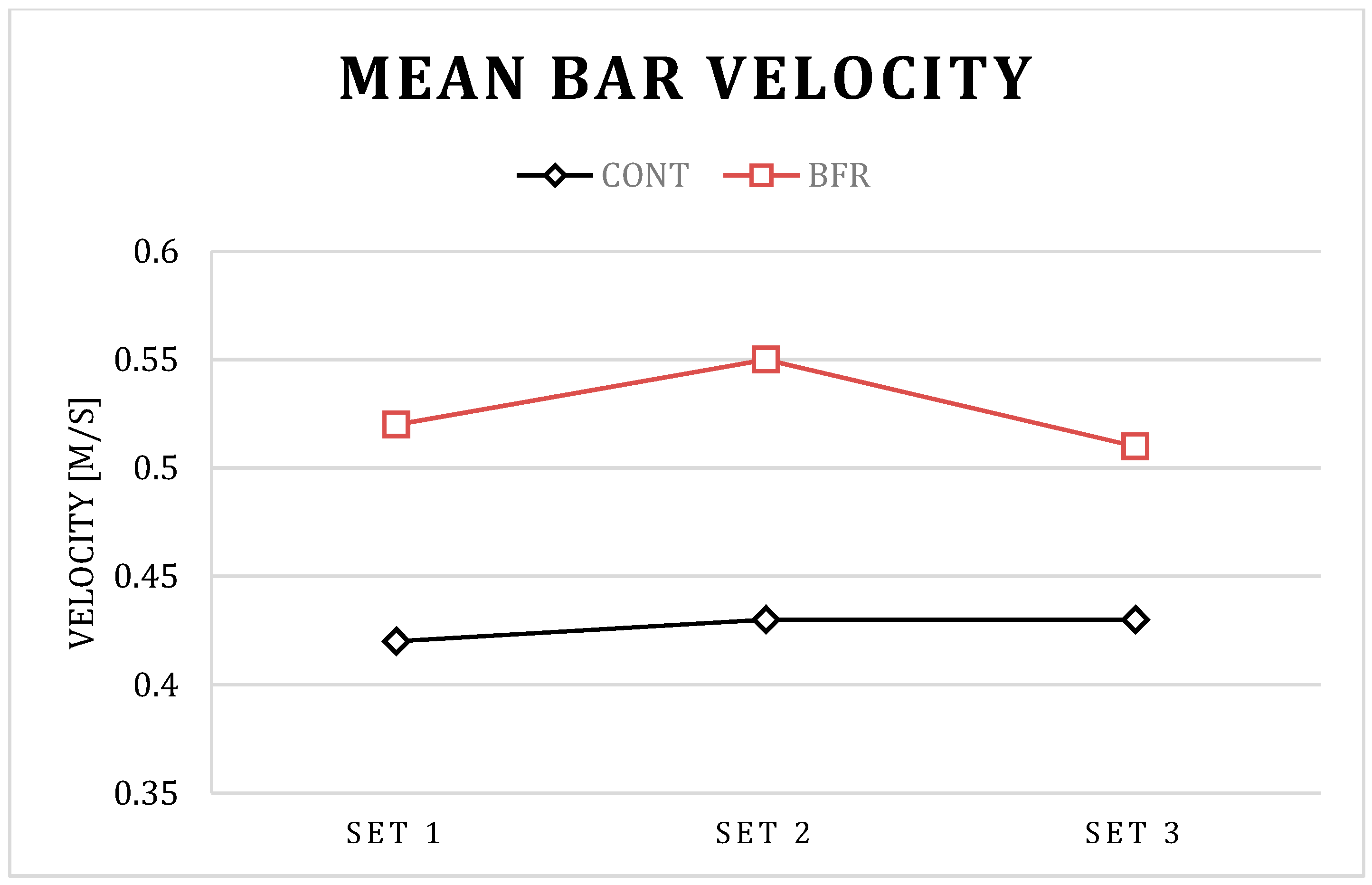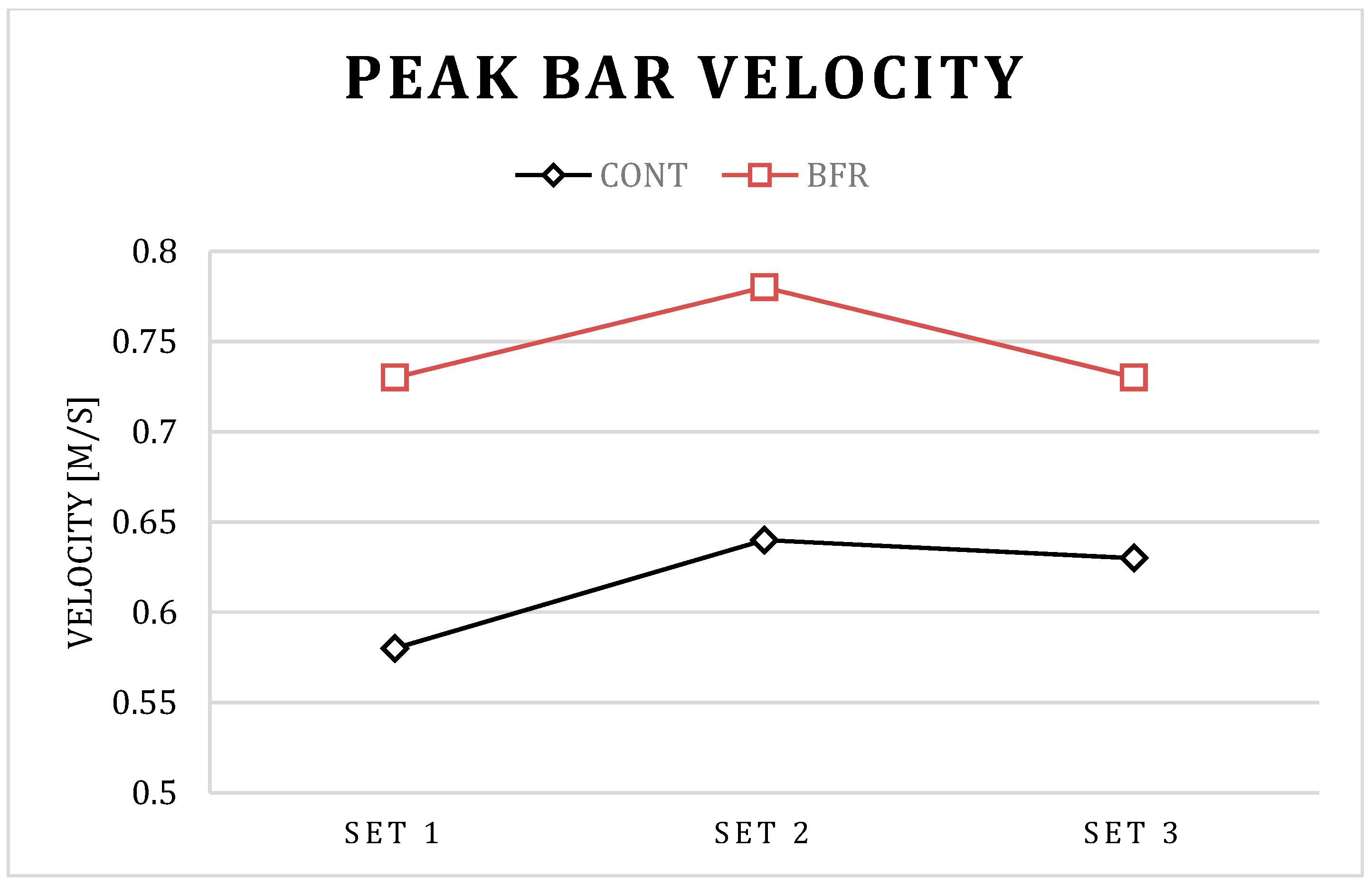Does Post-Activation Performance Enhancement Occur during the Bench Press Exercise under Blood Flow Restriction?
Abstract
1. Introduction
2. Methods
2.1. Participants
2.2. Familiarization Session and One Repetition Maximum Test
2.3. Experimental Sessions
2.4. Blood Flow Restriction
2.5. Statistical Analysis
3. Results
4. Discussion
Practical Implications
5. Conclusions
Author Contributions
Funding
Conflicts of Interest
References
- Cuenca-Fernández, F.; Smith, I.C.; Jordan, M.J.; MacIntosh, B.R.; López-Contreras, G.; Arellano, R.; Herzog, W. Nonlocalized postactivation performance enhancement (PAPE) effects in trained athletes: A pilot study. Appl. Physiol. Nutr. Metab. 2017, 42, 1122–1125. [Google Scholar] [CrossRef] [PubMed]
- Tillin, N.A.; Bishop, D. Factors Modulating Post-Activation Potentiation and its Effect on Performance of Subsequent Explosive Activities. Sports Med. 2009, 39, 147–166. [Google Scholar] [CrossRef] [PubMed]
- Wilk, M.; Krzysztofik, M.; Drozd, M.; Zajac, A. Changes of Power Output and Velocity During Successive Sets of the Bench Press with Different Duration of Eccentric Movement. Int. J. Sports Physiol. Perform. 2020, 15, 162–167. [Google Scholar] [CrossRef] [PubMed]
- Krzysztofik, M.; Wilk, M.; Filip, A.; Zmijewski, P.; Zajac, A.; Tufano, J.J. Can Post-Activation Performance Enhancement (PAPE) Improve Resistance Training Volume during the Bench Press Exercise? Int. J. Environ. Res. Public Health 2020, 17, 2554. [Google Scholar] [CrossRef] [PubMed]
- Golas, A.; Wilk, M.; Stastny, P.; Maszczyk, A.; Pajerska, K.; Zając, A. Optimizing Half Squat Postactivation Potential Load in Squat Jump Training for Eliciting Relative Maximal Power in Ski Jumpers. J. Strength Cond. Res. 2017, 31, 3010–3017. [Google Scholar] [CrossRef] [PubMed]
- Sale, D.G. Postactivation potentiation: Role in human performance. Exerc. Sport Sci. Rev. 2002, 30, 138–143. [Google Scholar] [CrossRef]
- Marques, M.C.; van den Tillaar, R.; Vescovi, J.D.; González-Badillo, J.J. Relationship Between Throwing Velocity, Muscle Power, and Bar Velocity During Bench Press in Elite Handball Players. Int. J. Sports Physiol. Perform. 2007, 2, 414–422. [Google Scholar] [CrossRef]
- Blazevich, A.J.; Babault, N. Post-activation Potentiation Versus Post-activation Performance Enhancement in Humans: Historical Perspective, Underlying Mechanisms, and Current Issues. Front. Physiol. 2019, 10, 1359. [Google Scholar] [CrossRef]
- Gossen, E.R.; Sale, D.G. Effect of postactivation potentiation on dynamic knee extension performance. Eur. J. Appl. Physiol. 2000, 83, 524–530. [Google Scholar] [CrossRef]
- Kilduff, L.P.; Owen, N.; Bevan, H.; Bennett, M.; Kingsley, M.I.C.; Cunningham, D. Influence of recovery time on post-activation potentiation in professional rugby players. J. Sports Sci. 2008, 26, 795–802. [Google Scholar] [CrossRef]
- Chiu, L.Z.F.; Fry, A.C.; Weiss, L.W.; Schilling, B.K.; Brown, L.E.; Smith, S.L. Postactivation potentiation response in athletic and recreationally trained individuals. J. Strength Cond. Res. 2003, 17, 671–677. [Google Scholar] [CrossRef]
- Farup, J.; Sørensen, H. Postactivation Potentiation: Upper Body Force Development Changes after Maximal Force Intervention. J. Strength Cond. Res. 2010, 24, 1874–1879. [Google Scholar] [CrossRef] [PubMed]
- Hrysomallis, C.; Kidgell, D. Effect of heavy dynamic resistive exercise on acute upper-body power. J. Strength Cond. Res. 2001, 15, 426–430. [Google Scholar] [PubMed]
- Tsoukos, A.; Brown, L.E.; Veligekas, P.; Terzis, G.; Bogdanis, G.C. Postactivation Potentiation of Bench Press Throw Performance Using Velocity-Based Conditioning Protocols with Low and Moderate Loads. J. Hum. Kinet. 2019, 68, 81–98. [Google Scholar] [CrossRef] [PubMed]
- Liossis, L.D.; Forsyth, J.; Liossis, C.; Tsolakis, C. The Acute Effect of Upper-Body Complex Training on Power Output of Martial Art Athletes as Measured by the Bench Press Throw Exercise. J. Hum. Kinet. 2013, 39, 167–175. [Google Scholar] [CrossRef] [PubMed]
- Morales-Artacho, A.J.; Padial, P.; García-Ramos, A.; Feriche, B. The Effect of the Number of Sets on Power Output for Different Loads. J. Hum. Kinet. 2015, 46, 149–156. [Google Scholar] [CrossRef] [PubMed][Green Version]
- Wilk, M.; Krzysztofik, M.; Gepfert, M.; Poprzecki, S.; Gołaś, A.; Maszczyk, A. Technical and Training Related Aspects of Resistance Training Using Blood Flow Restriction in Competitive Sport-A Review. J. Hum. Kinet. 2018, 65, 249–260. [Google Scholar] [CrossRef]
- Loenneke, J.P.; Pujol, T.J. The Use of Occlusion Training to Produce Muscle Hypertrophy. Strength Cond. J. 2009, 31, 77–84. [Google Scholar] [CrossRef]
- Scott, B.R.; Loenneke, J.P.; Slattery, K.M.; Dascombe, B.J. Exercise with Blood Flow Restriction: An Updated Evidence-Based Approach for Enhanced Muscular Development. Sports Med. 2015, 45, 313–325. [Google Scholar] [CrossRef]
- Takarada, Y.; Takazawa, H.; Sato, Y.; Takebayashi, S.; Tanaka, Y.; Ishii, N. Effects of resistance exercise combined with moderate vascular occlusion on muscular function in humans. J. Appl. Physiol. 2000, 88, 2097–2106. [Google Scholar] [CrossRef]
- Jessee, M.B.; Mattocks, K.T.; Buckner, S.L.; Dankel, S.J.; Mouser, J.G.; Abe, T.; Loenneke, J.P. Mechanisms of Blood Flow Restriction: The New Testament. Tech. Ortho. 2018, 33, 72–79. [Google Scholar] [CrossRef]
- Allen, D.G.; Trajanovska, S. The multiple roles of phosphate in muscle fatigue. Front. Physio. 2012, 3. [Google Scholar] [CrossRef] [PubMed]
- Wilk, M.; Krzysztofik, M.; Filip, A.; Zajac, A.; Bogdanis, G.C.; Lockie, R.G. Short-Term Blood Flow Restriction Increases Power Output and Bar Velocity During the Bench Press. J. Strength Cond. Res. 2020, 5. [Google Scholar] [CrossRef] [PubMed]
- Teixeira, E.L.; Barroso, R.; Silva-Batista, C.; Laurentino, G.C.; Loenneke, J.P.; Roschel, H.; Ugrinowitsch, C.; Tricoli, V. Blood flow restriction increases metabolic stress but decreases muscle activation during high-load resistance exercise. Muscle Nerve. 2018, 57, 107–111. [Google Scholar] [CrossRef]
- Luebbers, P.E.; Fry, A.C.; Kriley, L.M.; Butler, M.S. The effects of a 7-week practical blood flow restriction program on well-trained collegiate athletes. J. Strength Cond. Res. 2014, 28, 2270–2280. [Google Scholar] [CrossRef]
- Rawska, M.; Gepfert, M.; Mostowik, A.; Krzysztofik, M.; Wojdala, G.; Lulinska, A.; Wilk, M. Does blood flow restriction influence the maximal number of repetitions performed during the bench press? A pilot study. Balt. J. Health Phys. Act. 2019, 9–17. [Google Scholar] [CrossRef]
- Krzysztofik, M.; Wilk, M.; Golas, A.; Lockie, R.G.; Maszczyk, A.; Zajac, A. Does Eccentric-only and Concentric-only Activation Increase Power Output? Med. Sci. Sports Exer. 2020, 52, 484–489. [Google Scholar] [CrossRef]
- Golas, A.; Maszczyk, A.; Zajac, A.; Mikolajec, K.; Stastny, P. Optimizing post activation potentiation for explosive activities in competitive sports. J. Hum. Kinet. 2016, 52, 95–106. [Google Scholar] [CrossRef]
- Wilk, M.; Golas, A.; Zmijewski, P.; Krzysztofik, M.; Filip, A.; Coso, J.D.; Tufano, J.J. The Effects of the Movement Tempo on the One-Repetition Maximum Bench Press Results. J. Hum. Kinet. 2020, 72, 151–159. [Google Scholar] [CrossRef]
- Wilk, M.; Gepfert, M.; Krzysztofik, M.; Mostowik, A.; Filip, A.; Hajduk, G.; Zajac, A. Impact of Duration of Eccentric Movement in the One-Repetition Maximum Test Result in the Bench Press among Women. J. Sport Sci. Med. 2020, 19, 317–322. [Google Scholar]
- Goldsmith, J.A.; Trepeck, C.; Halle, J.L.; Mendez, K.M.; Klemp, A.; Cooke, D.M.; Haischer, M.H.; Byrnes, R.K.; Zoeller, R.F.; Whitehurst, M.; et al. Validity of the Open Barbell and Tendo Weightlifting Analyzer Systems Versus the Optotrak Certus 3D Motion-Capture System for Barbell Velocity. Int. J. Sports Physiol. Perform. 2019, 14, 540–543. [Google Scholar] [CrossRef] [PubMed]
- Patterson, S.D.; Hughes, L.; Warmington, S.; Burr, J.; Scott, B.R.; Owens, J.; Abe, T.; Nielsen, J.L.; Libardi, C.A.; Laurentino, G.; et al. Blood Flow Restriction Exercise Position Stand: Considerations of Methodology, Application, and Safety. Front. Physiol. 2019, 10. [Google Scholar] [CrossRef]
- Cohen, J. Statistical Power Analysis for the Behavioral Sciences, 2nd ed.; L. Erlbaum Associates: Hillsdale, NJ, USA, 1988. [Google Scholar]
- Abe, T.; Kearns, C.F.; Sato, Y. Muscle size and strength are increased following walk training with restricted venous blood flow from the leg muscle, Kaatsu-walk training. J. Appl. Physiol. 2006, 100, 1460–1466. [Google Scholar] [CrossRef] [PubMed]
- Lixandrão, M.E.; Ugrinowitsch, C.; Laurentino, G.; Libardi, C.A.; Aihara, A.Y.; Cardoso, F.N.; Tricoli, V.; Roschel, H. Effects of exercise intensity and occlusion pressure after 12 weeks of resistance training with blood-flow restriction. Eur. J. Appl. Physiol. 2015, 115, 2471–2480. [Google Scholar] [CrossRef]
- Lowery, R.P.; Joy, J.M.; Loenneke, J.P.; de Souza, E.O.; Machado, M.; Dudeck, J.E.; Wilson, J.M. Practical blood flow restriction training increases muscle hypertrophy during a periodized resistance training programme. Clin. Physiol. Funct. Imaging 2014, 34, 317–321. [Google Scholar] [CrossRef]
- Miller, R.M.; Keeter, V.M.; Freitas, E.D.S.; Heishman, A.D.; Knehans, A.W.; Bemben, D.A.; Bemben, M.G. Effects of Blood-Flow Restriction Combined with Postactivation Potentiation Stimuli on Jump Performance in Recreationally Active Men. J. Strength Cond. Res. 2018, 32, 1869–1874. [Google Scholar] [CrossRef] [PubMed]
- Cleary, C.J.; Cook, S.B. Postactivation Potentiation in Blood Flow–Restricted Complex Training. J. Strength Cond. Res. 2020, 34, 905–910. [Google Scholar] [CrossRef]
- Fujita, S.; Abe, T.; Drummond, M.J.; Cadenas, J.G.; Dreyer, H.C.; Sato, Y.; Volpi, E.; Rasmussen, B.B. Blood flow restriction during low-intensity resistance exercise increases S6K1 phosphorylation and muscle protein synthesis. J. Appl. Physiol. 2007, 103, 903–910. [Google Scholar] [CrossRef] [PubMed]
- Chaouachi, A.; Poulos, N.; Abed, F.; Turki, O.; Brughelli, M.; Chamari, K.; Drinkwater, E.J.; Behm, D.G. Volume, intensity, and timing of muscle power potentiation are variable. Appl. Physiol. Nutr. Metab. 2011, 36, 736–747. [Google Scholar] [CrossRef] [PubMed]
- Counts, B.R.; Dankel, S.J.; Barnett, B.E.; Kim, D.; Mouser, J.G.; Allen, K.M.; Thiebaud, R.S.; Abe, T.; Bemben, M.G.; Loenneke, J.P. Influence of relative blood flow restriction pressure on muscle activation and muscle adaptation: Relative BFR Pressure. Muscle Nerve. 2016, 53, 438–445. [Google Scholar] [CrossRef]
- Wilk, M.; Krzysztofik, M.; Filip, A.; Lockie, R.G.; Zajac, A. The acute effects of external compression with blood flow restriction on maximal strength and strength-endurance performance of the upper limbs. Front. Physiol. 2020, in press. [Google Scholar] [CrossRef]
- Golas, A.; Maszczyk, A.; Stastny, P.; Wilk, M.; Ficek, K.; Lockie, R.; Zajac, A. A New Approach to EMG Analysis of Closed-Circuit Movements Such as the Flat Bench Press. Sports 2018, 6, 27. [Google Scholar] [CrossRef] [PubMed]
- Yasuda, T.; Fujita, S.; Ogasawara, R.; Sato, Y.; Abe, T. Effects of low-intensity bench press training with restricted arm muscle blood flow on chest muscle hypertrophy: A pilot study: Bench press training with blood flow restriction. Clin. Physiol. Funct. Imaging. 2010, 30, 338–343. [Google Scholar] [CrossRef] [PubMed]
- Chudecka, M. The use of thermal imaging in the evaluation of the body surface temperature in various physiological states and in patients with different body composition and varying levels of physical activity. Cent. Eur. J. Sport Sci. Med. 2013, 2, 15–20. [Google Scholar]
- Abate, M.; Di Carlo, L.; Di Donato, L.; Romani, G.L.; Merla, A. Comparison of cutaneous termic response to a standardised warm up in trained and untrained individuals. J. Sports Med. Phys. Fitness 2013, 53, 209–215. [Google Scholar]
- Formenti, D.; Ludwig, N.; Trecroci, A.; Gargano, M.; Michielon, G.; Caumo, A.; Alberti, G. Dynamics of thermographic skin temperature response during squat exercise at two different speeds. J. Therm. Biol. 2016, 59, 58–63. [Google Scholar] [CrossRef]
- Ellefsen, S.; Hammarström, D.; Strand, T.A.; Zacharoff, E.; Whist, J.E.; Rauk, I.; Nygaard, H.; Vegge, G.; Hanestadhaugen, M.; Wernbom, M.; et al. Blood flow-restricted strength training displays high functional and biological efficacy in women: A within-subject comparison with high-load strength training. Am. J. Physiol. Regul. Integr. Comp. Physiol. 2015, 309, R767–R779. [Google Scholar] [CrossRef]
- Kacin, A.; Strazar, K. Frequent low-load ischemic resistance exercise to failure enhances muscle oxygen delivery and endurance capacity: Ischemic training and muscle endurance. Scand. J. Med. Sci. Sports 2011, 21, e231–e241. [Google Scholar] [CrossRef]




| Set 1 | Set 2 | Set 3 | |
|---|---|---|---|
| Peak Power Output (W) | |||
| CONT (95% CI) | 753 ± 6 (708 to 799) | 809 ± 100 (738 to 880) | 813 ± 93 (746 to 879) |
| BFR (95% CI) | 938 ± 82 (879 to 996) | 1011 ± 103 (938 to 1085) | 946 ± 105 (871 to 1021) |
| Mean Power Output (W) | |||
| CONT (95% CI) | 546 ± 55( 507 to 585) | 570 ± 6 (522 to 617) | 561 ± 79 (505 to 617) |
| BFR(95% CI) | 657 ± 92 (591 to 723) | 687 ± 105 (611 to 762) | 658 ± 86 (596 to 719) |
| Peak Bar Velocity (m/s) | |||
| CONT (95% CI) | 0.58 ± 0.09 (0.52 to 0.64) | 0.64 ± 0.10 (0.56 to 0.71) | 0.63 ± 0.09 (0.56 to 0.69) |
| BFR (95% CI) | 0.73 ± 0.06 (0.68 to 0.77) | 0.78 ± 0.08 (0.72 to 0.83) | 0.73 ± 0.10 (0.65 to 0.80) |
| Mean Bar Velocity (m/s) | |||
| CONT (95% CI) | 0.42 ± 0.08 (0.36 to 0.48) | 0.43 ± 0.07 (0.38 to 0.48) | 0.43 ± 0.06 (0.38 to 0.47) |
| BFR (95% CI) | 0.52 ± 0.07 (0.47 to 0.57) | 0.55 ± 0.08 (0.49 to 0.60) | 0.51 ± 0.08 (0.46 to 0.57) |
| Bench Press | CONT | BFR | Mean Difference | 95% CI for Difference | p | ES |
|---|---|---|---|---|---|---|
| Differences between sets | Mean Power Output | |||||
| Set 2–set 1 | 23.7 ± 28.2 | 29.1 ± 16.5 | 5.4 | −27.43 to 16.63 | 0.59 | 0.23 |
| Set 3–set 1 | 15.1 ± 48.4 | 0.5 ± 27.3 | 14.6 | −34.5 to 63.6 | 0.52 | 0.37 |
| Set 3–set 2 | −8.6 ± 24.8 | −28.6 ± 34.8 | 20.0 | −12.6 to 52.6 | 0.20 | 0.66 |
| Differences between sets | Peak Power Output | |||||
| Set 2–set 1 | 55.7 ± 40.7 | 73.7 ± 56.8 | 18.0 | −54.5 to 18.5 | 0.29 | 0.36 |
| Set 3–set 1 | 59.2 ± 44.2 | 8.7 ± 71.1 | 50.5 | −10.1 to 111.1 | 0.09 | 0.85 |
| Set 3–set 2 | 3.5 ± 29.9 | −65.0 ± 39.4 | 68.5 | 24.8 to 112.2 | 0.01* | 1.96 |
| Differences between sets | Mean Bar Velocity | |||||
| Set 2–set 1 | 0.015 ± 0.025 | 0.028 ± 0.019 | 0.013 | −0.034 to 0.008 | 0.20 | 0.59 |
| Set 3–set 1 | 0.007 ± 0.058 | −0.007 ± 0.020 | 0.014 | −0.039 to 0.067 | 0.57 | 0.32 |
| Set 3–set 2 | −0.008 ± 0.040 | −0.035 ± 0.033 | 0.027 | −0.014 to 0.068 | 0.17 | 1.15 |
| Differences between sets | Peak Bar Velocity | |||||
| Set 2–set 1 | 0.054 ± 0.033 | 0.053 ± 0.029 | 0.001 | −0.029 to 0.031 | 0.94 | 0.03 |
| Set 3–set 1 | 0.042 ± 0.037 | −0.001 ± 0.053 | 0.043 | −0.004 to 0.089 | 0.07 | 0.94 |
| Set 3–set 2 | −0.012 ± 0.017 | −0.054 ± 0.037 | 0.042 | 0.006 to 0.078 | 0.03 * | 1.46 |
| Peak Power Output | Mean Power Output | Peak Velocity | Mean Velocity | |||||||||
|---|---|---|---|---|---|---|---|---|---|---|---|---|
| Bench Press | Mean Difference | p | Effect Size | Mean Difference | p | Effect Size | Mean Difference | p | Effect Size | Mean Difference | p | Effect Size |
| CONT | ||||||||||||
| Set 2 vs. Set 1 | 74 | 0.01 * | 0.67 | 24 | 0.03 * | 0.40 | 0.06 | 0.01 * | 0.63 | 0.01 | 0.09 | 0.13 |
| Set 3 vs. Set 1 | 78 | 0.01 * | 0.76 | 15 | 0.35 | 0.22 | 0.05 | 0.01 * | 0.55 | 0.01 | 0.71 | 0.14 |
| Set 3 vs. Set 2 | 4 | 0.72 | 0.04 | 9 | 0.30 | 0.12 | 0.01 | 0.06 | 0.10 | 0.00 | 0.54 | 0.00 |
| BFR | ||||||||||||
| Set 2 vs. Set 1 | 73 | 0.01 * | 0.78 | 30 | 0.01 * | 0.30 | 0.05 | 0.01 * | 0.71 | 0.03 | 0.01 * | 0.40 |
| Set 3 vs. Set 1 | 8 | 0.71 | 0.08 | 1 | 0.95 | 0.01 | 0.00 | 0.95 | 0.00 | 0.01 | 0.30 | 0.13 |
| Set 3 vs. Set 2 | 65 | 0.01 * | 0.62 | 29 | 0.03 * | 0.30 | 0.05 | 0.01 * | 0.55 | 0.04 | 0.01 * | 0.50 |
| Peak Power Output | Mean Power Output | Peak Velocity | Mean Velocity | |||||||||
|---|---|---|---|---|---|---|---|---|---|---|---|---|
| Mean Difference | p | Effect Size | Mean Difference | p | Effect Size | Mean Difference | p | Effect Size | Mean Difference | p | Effect Size | |
| CONT vs. BFR | ||||||||||||
| Set 1 | 185 | 0.01 * | 3.18 | 111 | 0.01 * | 1.46 | 0.15 | 0.01 * | 1.96 | 0.10 | 0.01 * | 1.33 |
| Set 2 | 202 | 0.01 * | 1.99 | 117 | 0.01 * | 1.57 | 0.14 | 0.01 * | 1.55 | 0.12 | 0.01 * | 1.60 |
| Set 3 | 133 | 0.01 * | 1.34 | 97 | 0.01 * | 1.17 | 0.10 | 0.01 * | 1.05 | 0.08 | 0.01 * | 1.13 |
© 2020 by the authors. Licensee MDPI, Basel, Switzerland. This article is an open access article distributed under the terms and conditions of the Creative Commons Attribution (CC BY) license (http://creativecommons.org/licenses/by/4.0/).
Share and Cite
Wilk, M.; Krzysztofik, M.; Filip, A.; Szkudlarek, A.; Lockie, R.G.; Zajac, A. Does Post-Activation Performance Enhancement Occur during the Bench Press Exercise under Blood Flow Restriction? Int. J. Environ. Res. Public Health 2020, 17, 3752. https://doi.org/10.3390/ijerph17113752
Wilk M, Krzysztofik M, Filip A, Szkudlarek A, Lockie RG, Zajac A. Does Post-Activation Performance Enhancement Occur during the Bench Press Exercise under Blood Flow Restriction? International Journal of Environmental Research and Public Health. 2020; 17(11):3752. https://doi.org/10.3390/ijerph17113752
Chicago/Turabian StyleWilk, Michal, Michal Krzysztofik, Aleksandra Filip, Agnieszka Szkudlarek, Robert G. Lockie, and Adam Zajac. 2020. "Does Post-Activation Performance Enhancement Occur during the Bench Press Exercise under Blood Flow Restriction?" International Journal of Environmental Research and Public Health 17, no. 11: 3752. https://doi.org/10.3390/ijerph17113752
APA StyleWilk, M., Krzysztofik, M., Filip, A., Szkudlarek, A., Lockie, R. G., & Zajac, A. (2020). Does Post-Activation Performance Enhancement Occur during the Bench Press Exercise under Blood Flow Restriction? International Journal of Environmental Research and Public Health, 17(11), 3752. https://doi.org/10.3390/ijerph17113752










